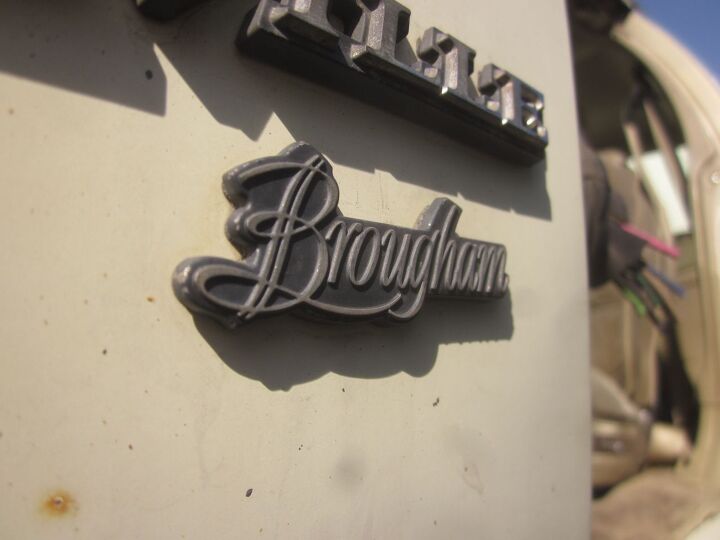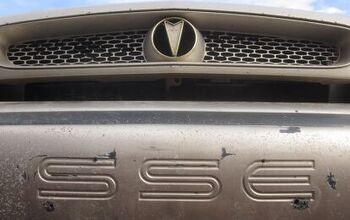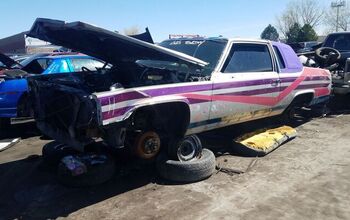Junkyard Find: 1981 Pontiac Bonneville Brougham

Here’s a Junkyard Find that really takes me back. My dad bought a Bonneville new in 1979, and it seemed like a very nice car when I was 13 years old. A few years later, I borrowed the Bonneville to take my date to the high-school prom (in spite of this being the early 1980s, I did not wear a robin’s-egg-blue tuxedo, though now I wish I had), and I felt classier than Frank Sinatra in a brand-new ’61 Imperial. A few years after that, I was given the now-quite-worn-out Bonneville to make the drive between the San Francisco Bay Area and my new home in Southern California… and it crapped out every 100 yards while trying to climb the Grapevine. So, mixed feelings when I saw this very similar ’81 Bonneville Brougham in a Denver self-service yard.
I’m not sure what luxury touches the Brougham option package got Bonneville buyers in 1981. Maybe just the Brougham emblems.
Perhaps the diamond-tucked velour upholstery was a Brougham-only option for ’81. Make sure your prom date doesn’t ralph up her Boone’s Farm on these impossible-to-clean seats!
I recall the Bonneville being a very smooth-riding, comfortable car. Quite underpowered with its 301-cubic-inch V8, and the electrical stuff started failing right away, but pretty decent by the low standards of the Middle Malaise Era.

Murilee Martin is the pen name of Phil Greden, a writer who has lived in Minnesota, California, Georgia and (now) Colorado. He has toiled at copywriting, technical writing, junkmail writing, fiction writing and now automotive writing. He has owned many terrible vehicles and some good ones. He spends a great deal of time in self-service junkyards. These days, he writes for publications including Autoweek, Autoblog, Hagerty, The Truth About Cars and Capital One.
More by Murilee Martin
Latest Car Reviews
Read moreLatest Product Reviews
Read moreRecent Comments
- Jalop1991 In a manner similar to PHEV being the correct answer, I declare RPVs to be the correct answer here.We're doing it with certain aircraft; why not with cars on the ground, using hardware and tools like Telsa's "FSD" or GM's "SuperCruise" as the base?Take the local Uber driver out of the car, and put him in a professional centralized environment from where he drives me around. The system and the individual car can have awareness as well as gates, but he's responsible for the driving.Put the tech into my car, and let me buy it as needed. I need someone else to drive me home; hit the button and voila, I've hired a driver for the moment. I don't want to drive 11 hours to my vacation spot; hire the remote pilot for that. When I get there, I have my car and he's still at his normal location, piloting cars for other people.The system would allow for driver rest period, like what's required for truckers, so I might end up with multiple people driving me to the coast. I don't care. And they don't have to be physically with me, therefore they can be way cheaper.Charge taxi-type per-mile rates. For long drives, offer per-trip rates. Offer subscriptions, including miles/hours. Whatever.(And for grins, dress the remote pilots all as Johnnie.)Start this out with big rigs. Take the trucker away from the long haul driving, and let him be there for emergencies and the short haul parts of the trip.And in a manner similar to PHEVs being discredited, I fully expect to be razzed for this brilliant idea (not unlike how Alan Kay wasn't recognized until many many years later for his Dynabook vision).
- B-BodyBuick84 Not afraid of AV's as I highly doubt they will ever be %100 viable for our roads. Stop-and-go downtown city or rush hour highway traffic? I can see that, but otherwise there's simply too many variables. Bad weather conditions, faded road lines or markings, reflective surfaces with glare, etc. There's also the issue of cultural norms. About a decade ago there was actually an online test called 'The Morality Machine' one could do online where you were in control of an AV and choose what action to take when a crash was inevitable. I think something like 2.5 million people across the world participated? For example, do you hit and most likely kill the elderly couple strolling across the crosswalk or crash the vehicle into a cement barrier and almost certainly cause the death of the vehicle occupants? What if it's a parent and child? In N. America 98% of people choose to hit the elderly couple and save themselves while in Asia, the exact opposite happened where 98% choose to hit the parent and child. Why? Cultural differences. Asia puts a lot of emphasis on respecting their elderly while N. America has a culture of 'save/ protect the children'. Are these AV's going to respect that culture? Is a VW Jetta or Buick Envision AV going to have different programming depending on whether it's sold in Canada or Taiwan? how's that going to effect legislation and legal battles when a crash inevitibly does happen? These are the true barriers to mass AV adoption, and in the 10 years since that test came out, there has been zero answers or progress on this matter. So no, I'm not afraid of AV's simply because with the exception of a few specific situations, most avenues are going to prove to be a dead-end for automakers.
- Mike Bradley Autonomous cars were developed in Silicon Valley. For new products there, the standard business plan is to put a barely-functioning product on the market right away and wait for the early-adopter customers to find the flaws. That's exactly what's happened. Detroit's plan is pretty much the opposite, but Detroit isn't developing this product. That's why dealers, for instance, haven't been trained in the cars.
- Dartman https://apnews.com/article/artificial-intelligence-fighter-jets-air-force-6a1100c96a73ca9b7f41cbd6a2753fdaAutonomous/Ai is here now. The question is implementation and acceptance.
- FreedMike If Dodge were smart - and I don't think they are - they'd spend their money refreshing and reworking the Durango (which I think is entering model year 3,221), versus going down the same "stuff 'em full of motor and give 'em cool new paint options" path. That's the approach they used with the Charger and Challenger, and both those models are dead. The Durango is still a strong product in a strong market; why not keep it fresher?























































Comments
Join the conversation
The old man purchased a Bonneville sedan when it bacame a downsized mid-size I believe in 1982 .He didn't like it for some reason - might have been the v-6 which ran poorly and idled roughly . It was the first Bonneville he bought since a 1960 Bonnevile Safari but it no longer was any kind of luxury car as it had been then .When the Parisienne - believe that was just the same car as the previous full size Bonneville but built in Canada- came out he promptly traded the smaller Bonneville for one of those .
So you are aware, the engine in the Bonneville pictured is a Oldsmobile Diesel 350. The Pontiac 301 has a distinct profile, very similar to the bigger Pontiac V8's, they share the same timing covers, valve covers, etc... The oil filling tube sticking high into the air is a dead give away you're looking at an Oldsmobile engine. That Oldsmobile diesel V8 has it's own sad story.